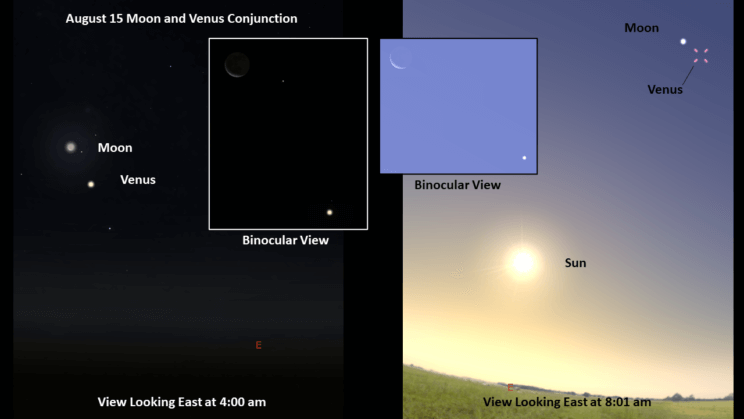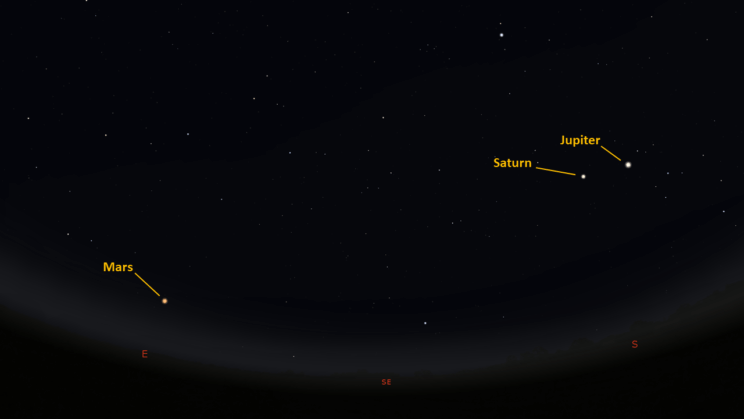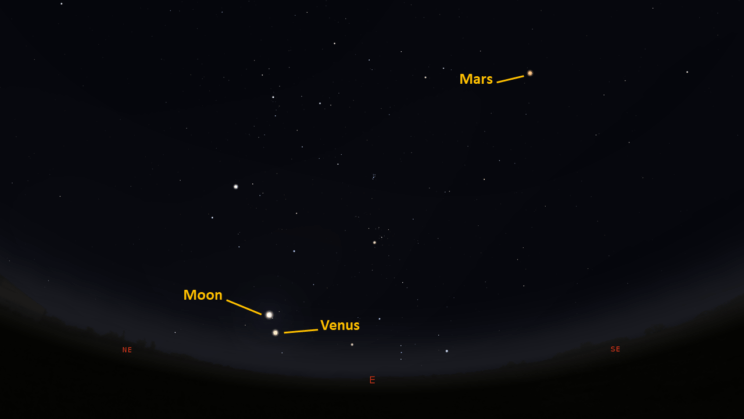This is the Saint Louis Science Center’s NIGHT SKY UPDATE for the week of Friday, August 14, 2020.
Information updated weekly or as needed.
Times given as local St. Louis time (CDT). For definitions of terminology used in the night sky update, click the highlighted text.
Public Telescope Viewings
Star parties at the Saint Louis Science Center have temporarily been canceled due to recommendations from the CDC regarding COVID-19. All public telescope events are canceled until further notice. As conditions change, we will reevaluate and update this article once public observing events resume.
Observing Highlight of the Week

Moon/Venus Conjuntion Looking East Before After Sunrise August 15, 2020
Credit: Stellarium, EG
On Saturday, August 15, a 25-day old Moon and the planet Venus will reach conjunction at 8:01 a.m. Conjunctions are when two or more celestial bodies share the same right ascension. This basically means we will see the Moon and Venus appear near one another in the sky. The downside is the Sun will be up, so to see the pair at conjunction you will need to use binoculars.
The Moon and Venus will appear just under 4° apart. The paring of the Moon and all the planets occurs frequently because they are all seen in the same path across the sky. Each month the Moon appears to pass by each planet as it completes an orbit. The path that the Sun, Moon and planets appear to follow is marked by the Zodiac constellations.
If you plan to observe this conjunction, take special care to ensure you DO NOT LOOK AT THE SUN! My recommendation to ensure you do not look near the Sun is to use a building to obscure the Sun from view. At 8:01 a.m. the Sun will only be about 20° above the eastern horizon. This should make it easy to obscure the Sun by standing to the side of a building. The Moon and Venus will be about 63° above the eastern horizon and will not yet be overhead. If you do not want to risk an accidental look at the Sun, you can see the Moon and Venus together as they rise about 3.5 hours before the Sun. The angular separation between the pair will be nearly the same as it is during this conjunction.
The Moon will exhibit a waning crescent phase with about 15% of the lunar disk illuminated. Venus is past greatest western elongation and is headed towards superior conjunction. This means Venus will exhibit a gibbous phase with about 51.4% disk illumination. To see the phases of Venus you will need to use a telescope or large binoculars.
Tracking down the planets in daylight is a challenging and rewarding project. However, due to the danger of the Sun being visible, it is not recommended to those just beginning. You will need to know exactly were to look to ensure you do not accidentally look towards the Sun. For more information on this conjunction event, visit https://in-the-sky.org/news.php?id=20200815_20_100
The Sun and Moon

The Moon as seen from the International Space Station, on July 31, 2011.
Credit: NASA
Sunrise is at 6:15 a.m. on Friday, August 14 and sunset is at 7:56 p.m. providing us with under 14 hours of daylight. Even after sunset, the light from the Sun will dimly illuminate our sky for about 1 hour and 40 minutes. This period is called twilight, which ends around 9:35 p.m. this week. For those with a sundial, local noon occurs around 1:06 p.m. this week.
Solar Cycle 25
The Sun’s magnetic field exhibits a cycle that lasts about 11 years during which the Sun’s magnetic field flips polarity. This cycle is known as the Solar Cycle. Extremes of this cycle are called solar minimum and solar maximum which are related to solar activity such as sunspots, solar flares and coronal mass ejections. The occurrence of these solar events directly impacts the Earth whether their occurrences are high or low. The effects of this kind of solar activity is called space weather which is critical to study due to impacts it can have on life on Earth.
Recently the Sun started to increase sunspot development which is a sign that the new solar cycle is starting to pick up. The new cycle beginning is Solar Cycle 25. Solar cycles have been getting weaker and we are just now coming out of one of the deepest solar minimums of recent history. For those that have telescopes equipped with safe solar filters, this will be welcome news as we can look forward to increased and observable solar activity. Observing the Sun can be very dangerous, and it should only be done if you know for sure you have proper safe solar equipment. If you are unsure or are interested in learning about safe solar observing, the Stanford Solar Center has excellent information regarding this topic.
| Day | Sunrise | Sunset |
|---|---|---|
| 2020-08-14 | 6:15 a.m. | 7:56 p.m. |
| 2020-08-15 | 6:16 a.m. | 7:55 p.m. |
| 2020-08-16 | 6:17 a.m. | 7:53 p.m. |
| 2020-08-17 | 6:18 a.m. | 7:52 p.m. |
| 2020-08-18 | 6:18 a.m. | 7:51 p.m. |
| 2020-08-19 | 6:19 a.m. | 7:49 p.m. |
| 2020-08-20 | 6:20 a.m. | 7:48 p.m. |
| 2020-08-21 | 6:20 a.m. | 7:46 p.m. |
| 2020-08-22 | 6:22 a.m. | 7:45 p.m. |
Moon
Moonrise for Friday, August 14 occurs at 1:33 a.m. and moonset will occur at 4:43 p.m. On Friday, August 14 the Moon will exhibit a waning crescent phase with about 21% of the lunar disk illuminated. New moon occurs on August 18 at 9:42 p.m.
International Space Station (ISS) Observing

There are no visible passes of ISS from St. Louis for the week of August 14. Visible passes of ISS will return to St. Louis skies on August 23. Instead of ISS, this week is a good opportunity to spot the X-37B spacecraft. The X-37B is a reusable robotic spacecraft that is operated by the US Space Force. After its mission, the X-37B returns to Earth as a space plane landing similar to how the Space Shuttle once did. There are several decent passes of X-37B this week during evening hours. These passes occur on August 17, 19 and 21. Use the table below for information regarding these passes.
Catch X-37B from St. Louis starting Friday, August 14
| Date | Starts | Max. altitude | Ends | |||||||
|---|---|---|---|---|---|---|---|---|---|---|
| Time | Alt. | Az. | Time | Alt. | Az. | Time | Alt. | Az. | ||
| 17 Aug | 1 | 21:15:15 | 10 | WNW | 21:18:21 | 52 | NNE | 21:19:17 | 36 | ENE |
| 19 Aug | 0.5 | 20:54:39 | 10 | WNW | 20:57:50 | 90 | NW | 20:59:22 | 28 | ESE |
| 21 Aug | 1.3 | 20:34:11 | 10 | WNW | 20:37:14 | 47 | SSW | 20:39:42 | 14 | SE |
Magnitude (Mag): The Measure of brightness for a celestial object. The lower the value is, the brighter the object will be.
Altitude (Alt): The angle of a celestial object measured upwards from the observer’s horizon.
Azimuth (Az): The direction of a celestial object, measured clockwise from an observer’s location with north being 0°, east being 90°, south being 180° and west being 270°.
For information about ISS flyovers and other visible satellites, visit www.heavens-above.com
Detailed information regarding all unmanned exploration of our universe, missions past, present, and planned, can be found at Jet Propulsion Laboratories:
The Visible Planets

Looking Southeast, at 11:30 pm, August 14, 2020
Credit: Stellarium, EG

Looking East, 3:30 am, August 15, 2020
Credit: Stellarium, EG
This week, four naked eye planets are visible. Jupiter and Saturn rise before sunset. Look for them in the southeast once it is dark. Mars rises in the late evening and will be best seen after midnight. Venus can be found in the eastern sky before sunrise.
For those tracking Jupiter and Saturn as they approach their great conjunction later this year, the two gas giants currently appear about 8.2° apart in the sky. Jupiter appears to be moving away from Saturn right now due to retrograde motion. This is all an illusion caused by Earth passing by slower moving Jupiter. Saturn is also exhibiting retrograde motion. If you keep watching these planets as 2020 progresses, you will see some interesting behaviors that inspired early astronomers to track the skies.
Venus
Venus is well into another morning apparition. After months of seeing Venus in the west after sunset Venus is now visible in the east before sunrise. Venus rises at 2:46 a.m. and will be easily seen by 3:30 a.m. Venus remains a morning object until March 26, 2021 when it reaches superior conjunction. Since Venus has passed greatest western elongation, it will start to exhibit a gibbous phase. This week disk illumination for Venus will start at 51% and end at 55%.
Mars
The red planet rises around 10:41 p.m. and will be high enough to see in the southeast by 11:40 p.m. Opposition for Mars occurs on October 13, 2020. As we head towards this date Mars will appear brighter and larger through a telescope improving surface details. Surface features are already visible when viewing conditions are favorable. Current apparent brightness of Mars is -1.4 magnitude.
Jupiter
Look for Jupiter in the southeast about 30 minutes after sunset. Those with a telescope can enjoy views of Jupiter’s cloud features and the Great Red Spot when it is pointed towards Earth.
Saturn
Look for the ringed planet in the southeast about 30 minutes after sunset. For those with a telescope keep track of the orientation of Saturn’s rings. Since Saturn is tilted on its rotational axis, we cross the plane of Saturn’s ring every 13 to 15 years. We are headed towards another ring plane crossing on March 23, 2025. Over the next five years you will notice Saturn’s rings will gradually incline towards an edge on appearance.
2020 Great Conjunction
This year the planets Jupiter and Saturn will reach conjunction. A conjunction is when two or more celestial bodies share the same right ascension. For Jupiter and Saturn this astronomical event occurs every 20 years. The conjunction occurs on December 21, 2020. You will find the two planets close together in the southwest just after sunset on this date.
Visit the James S. McDonnell Planetarium for more information on what’s up!
Night Sky Update: August 14-August 22, 2020






